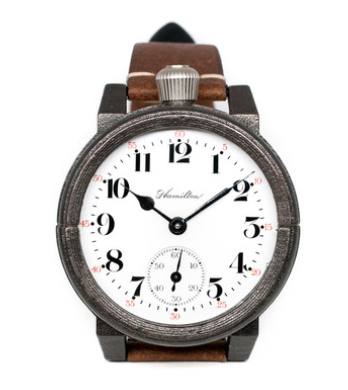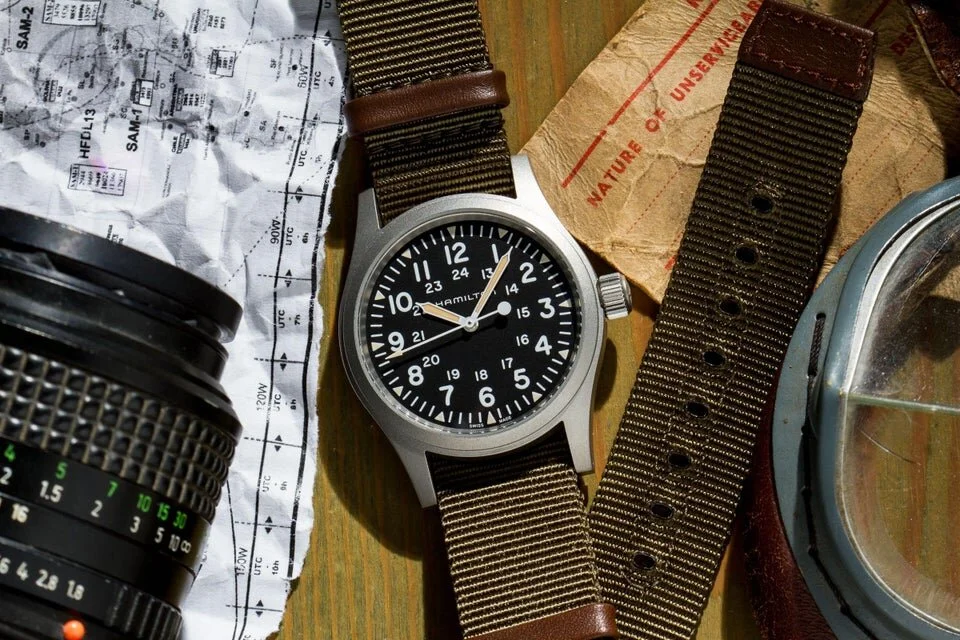This article is meant to give an overview of the facts and procedural stance of Hamilton International Ltd. v. Vortic LLC such that readers can form their own opinions as the case heads to trial.
It’s been a long two-plus years for Vortic Watches since megabrand Hamilton Watch Company filed a trademark infringement and counterfeiting lawsuit against it back in July of 2017 (see the original complaint here). But, the suit finally came to a head as a bench (i.e. non-jury trial) was held begin in the Southern District of New York on February 19 (Hamilton International Ltd. v. Vortic LLC, 17-CV-5575).
Case background and complaint
In 2017, Hamilton, an historically American watch brand now owned by Swiss conglomerate Swatch Group, filed suit against Vortic and founder R.T. Custer alleging trademark infringement and counterfeiting, as well as levying claims of false designation and unfair competition under the Lanham Act, the federal statute governing trademarks and unfair competition.
Vortic Watches is an engineering and manufacturing company based in Fort Collins, Colo. The company uses 3D printing to create new, custom-built wristwatch cases, then drops mechanical movements and dials it sources from old American-made pocket watches to create bespoke wristwatches. In addition to manufacturing the case, Vortic also gets the original mechanical movement in working order, which at least sometimes means using movement parts from multiple antique watches.
In building these watches, Vortic maintains and restores the original dials and movements, meaning the branding of the original timepiece is kept. Visiting their website, you’ll see watches with dials from historic American watch brands like Illinois, Waltham, and others. Before Hamilton filed its complaint, Vortic’s offerings also included wristwatches with dials and movements bearing the Hamilton name.
In addition to bringing claims regarding Vortic’s watches, Hamilton also asserts that Vortic’s advertising materials — including its website — improperly suggest an affiliation with Hamilton. Hamilton alleges that the advertisements and watches are “likely to cause confusion”, in the market, thus infringing on Hamilton’s trademarks, and additionally that the use of the Hamilton name will wrongly cause consumers to believe Vortic’s watches are endorsed by or associated with Hamilton.
The Vortic ‘Lancaster’ that Hamilton took issue with | Touch of Modern
In its original complaint, Hamilton sought damages including: (i) a court order permanently preventing Vortic from using the Hamilton name in its products or advertising, (ii) Vortic’s return of any materials (e.g. products, computer code, molds, advertising materials) bearing the Hamilton name, and (iii) monetary damages (including attorneys’ fees for the cost of the suit), and that Vortic’s conduct be found willful such that damages may be tripled.
That’s just mean
You’ll also find court records from 2018 evidencing what looks to be Hamilton’s pretty blatant shirking of a settlement conference. The court scheduled two meetings between the parties in New York to discuss a potential settlement, and a Hamilton representative neglected to attend either, even after the court had said the representative could attend via phone. This came after Vortic’s Custer came to New York to attend the conference in person. Because of Hamilton’s bad faith actions, it was sanctioned and ordered to pay for Custer’s travel and expenses.
Summary judgment
In September 2019, the court ruled on Hamilton’s movement for summary judgment — essentially, a request that the court decide the case in Hamilton’s favor before a full trial — providing a glimpse into where the case stood. The court denied Hamilton’s motion on all counts, setting up the trial that is now expected this week. Denying a motion for summary judgment is basically the court saying “a reasonable jury could find for Vortic in this case”, i.e. that there are genuine disputes as to material facts that need to be resolved through a trial.
In denying the motion, the court laid out its reasoning, giving a glimpse into what either side will be arguing in court this week.
Trademark infringement claims
The only element of trademark infringement subject to dispute in this case is whether Vortic’s use of the Hamilton name could cause a “likelihood of confusion” among consumers, the standard for proving a claim of infringement. In determining whether there is a likelihood of confusion, the court in this case looks to: (i) actual confusion of consumers, (ii) the defendant's good faith in adopting its own mark, and (iii) the sophistication of the buyers. That’s right folks, the sophistication of watch collectors as buyers is partially on trial here! Additionally, Hamilton must show there is a probability of confusion, not a mere possibility.
In addition to these factors, the court pointed out that in cases such as this one, involving genuinely modified products, adequate disclosure of the origin of the product has been enough to decide the case in the defendant’s favor. The court pointed to a case in which a defendant that sold reused spark plugs was found not to be infringing a trademark, so long as the spark plugs had “used” or “repaired” conspicuously stamped on them. In cases like this, the court weighs heavily this “disclosure” factor in determining whether there is a likelihood of confusion.
The advertisements
First, the court analyzed whether Vortic made adequate disclosure as to the origin of the products in the advertisements Hamilton took issue with. Taking the Vortic website first, the court points out that the branding Vortic had given the watch, “The Lancaster” and “American Artisan Series”, appeared in large bold letters. Then, in smaller print, the ad explains that the movement, dial and hands came from an antique pocket watch “made by Hamilton Watch Company,” going on to explain how Vortic builds its watches. The court ruled that a reasonable jury could conclude that this advertisement constituted “full disclosure” as to the fact that Vortic is producing watches from old Hamilton components, and thus clear Vortic of the infringement claim. The court applied the same reasoning and analysis to a similar print advertisement, as well as to a Vortic tweet, sending all three claims to trial.
The watch
Similar to its analysis of the advertisements, the court also ruled that a reasonably jury could look at the Vortic watch itself and conclude that full disclosure as to the source of Vortic’s components had been achieved. The court pointed out that Vortic’s wristwatches look like obviously modified pocket watches, additionally concluding that the Vortic name, serial number, and “Lancaster” branding might predominate over the original Hamilton marks. This might adequately lead a consumer to believe the Vortic product is what is, namely a Hamilton pocket watch that Vortic has restored and re-cased as a wristwatch.
As for the other factors to determine trademark infringement: actual confusion, the defendant’s good faith, and the sophistication of buyers, the court didn’t find enough evidence for Hamilton there either.
To prove actual confusion, Hamilton relied primarily on an email that a potential customer sent to Hamilton. That email had images of Vortic products attached, then asked the Hamilton recipient where it might find one. From a legal perspective that doesn’t prove much, does it? All it shows is that some consumer, somewhere, is interested in buying a vintage Hamilton watch, and Hamilton’s got Vortic to thank for it — that’s hardly dispositive.
Lastly, looking at the sophistication of consumers (that’s us!), the court quoted a previous decision in saying that “the average consumer spending hundreds of dollars on a watch that will be worn for years is likely to give close attention to the type of watch he or she is buying." So, we’re sophisticated, if only because we’re spending ridiculous amounts of money on these things.
With that, the court sent the trademark infringement claims regarding both the advertisements and the watches to trial.
Counterfeiting and Unfair Competition
The standard for a counterfeiting claims is similar to that of a trademark infringement claim: Hamilton must show that Vortic’s use of the mark is “likely to cause confusion, or to cause mistake, or to deceive”. Since the court ruled on the trademark infringement case that there is a dispute as to whether there is a likelihood of confusion, the court also sent the counterfeiting claim to trial. Similarly, the standard for an unfair competition claim is the same as for trademark infringement, so that claim moved to trial as well. Summary judgment was also denied on Hamilton’s dilution claim.
You’re the bad guy
While this case gets to the heart of many fundamental issues in the watch industry (and even the U.S. legal system), this analysis focuses on the legal framework that will be used by the court to decide the case. Of course, courts contemplate the broader implications of any decision they hand down, but they must do this within the bounds of legal precedent and analysis. It’s fair enough to say that Vortic’s founders are “good kids” or that Swatch Group is acting as a malicious luxury conglomerate (or to argue the opposite), but these statements have no direct implications for the legal arguments and decisions to be made in court this week.
Finally, about 97 percent of cases are decided outside of trial, so for any case to make it this far generally means the case could be decided for either party.
Footnote: Nominaitve fair use and Rolex v. laCalifornienne?
So that’s where Hamilton v. Vortic stands as it heads to trial. Another lawsuit in the watch industry being followed closely also involves alleged trademark infringement and counterfeiting. However, the Rolex v. Reference Watch (doing business as laCaliforienne) complaint was filed in California, so the New York court’s decision has no binding effect on what California courts might do.
In its initial response to Rolex’s suit, laCalifornienne raised an interesting affirmative defense that it doesn’t seem Vortic raised: nominative fair use.
As I wrote when initially covering laCalifornienne’s response to Rolex’s claims of trademark infringement and counterfeiting, California’s Ninth Circuit views nominative fair use as a separate test from the typical “likelihood of confusion” trademark infringement test. When nominative fair use has been invoked, the defendant’s use of the trademark is deemed fair use if three requirements are met: (1) the product in question cannot be readily identified without use of the trademark; (2) only so much of the mark is used as is reasonably necessary to identify the product; and (3) the defendant must do nothing that would suggest sponsorship or endorsement by the trademark holder. This nominative fair use test is used instead of a more intense factors-based analysis of the use of the trademark, increasing laCalifornienne’s chances of a win in court.
But, New York’s Second Circuit (where Hamilton v. Vortic is taking place) handles nominative fair use differently. Instead of swapping out the traditional likelihood of confusion test for the more lenient nominative fair use test analyzing the three factors above, the Second Circuit has decided that, in nominative fair use cases, these factors be analyzed in addition to the other traditional likelihood of confusion factors.
So, unlike laCalifornienne’s case in California where invoking nominative fair use may get its likelihood of confusion test completely swapped out for a more lenient test and standard, Vortic didn’t have as much to gain by invoking the defense in New York. This may seem like procedural mumbo-jumbo, but it’s important to understand both practically and legally.
A huge thanks to YouTube channel WatchWithUs for bringing the ensuing trial to my attention. For more opinions, read the lengthy Watchuseek thread on the case.


